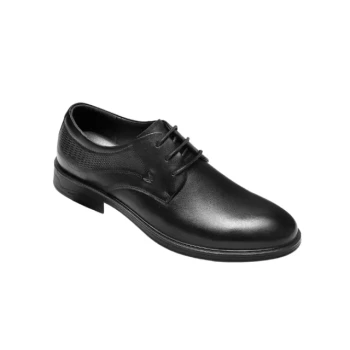The core difference is simple: A loafer is a type of shoe, while a brogue is a style of decoration. Loafers are slip-on shoes without laces, prized for their comfort and versatility. Brogues are any type of shoe—including loafers—that feature decorative perforations, known as "broguing," along their seams.
This isn't a comparison of two separate categories. The real question is understanding that "brogue" is a design feature that can be applied to many shoe types, including but not limited to, the slip-on loafer.
Deconstructing the Categories: Shoe vs. Style
The confusion between loafers and brogues stems from comparing a functional shoe silhouette with an aesthetic detail. Once you separate these concepts, the distinction becomes clear.
What Defines a Loafer?
A loafer is fundamentally a slip-on shoe with no laces or buckles. Its construction is defined by convenience and comfort.
This simple, laceless design makes it inherently more casual than traditional dress shoes like Oxfords, though its formality can vary significantly based on material (e.g., leather vs. suede) and specific design (e.g., a sleek Penny loafer vs. a Tassel loafer).
What Defines a Brogue?
A brogue is defined by its decorative perforations (broguing). This design element was originally functional, created by Irish and Scottish farmers to allow water to drain from their shoes while working in wet terrain.
Today, broguing is purely ornamental. It can be applied to almost any style of shoe, including Oxfords, Derbies, boots, and even loafers. A loafer with these perforations is correctly called a "brogue loafer."
Understanding the Impact on Formality
Both the shoe type and the amount of decoration play a role in determining how formal a shoe is. This is where the two concepts intersect.
The Loafer Formality Spectrum
Loafers exist on a wide spectrum of formality. A black leather penny loafer can be worn with a suit, while a suede driving loafer is strictly casual. The key is its slip-on nature, which always makes it slightly less formal than an equivalent lace-up shoe.
The Broguing Formality Rule
The more broguing a shoe has, the less formal it becomes. The perforations add visual texture and detail, moving the shoe away from the sleek, clean lines of traditional dress footwear.
- Full-Brogue (or Wingtip): Features extensive perforations, including a "W" shaped toe cap. This is the least formal style.
- Semi-Brogue: Has a perforated toe cap but lacks the "wings" of a full-brogue. It is more formal than a full-brogue.
- Quarter-Brogue: Features perforations only along the toe cap seam. This is the most formal style of brogue.
Common Pitfalls and Clarifications
Understanding the distinction helps you avoid common style mistakes and choose the right shoe for the occasion.
A Loafer Is Not Always a Casual Shoe
While its origins are casual, the modern loafer can be quite formal. A polished black leather Venetian or Penny loafer is a perfectly acceptable choice for business professional settings.
A Brogue Is Not a Specific Shoe Type
This is the most critical point. You cannot buy "a brogue" in the same way you buy "a loafer." You buy an Oxford brogue, a Derby brogue, or a loafer brogue. The term only describes the decorative detail.
Combining the Concepts
When you see a brogue loafer, you are looking at a shoe that combines the casual, slip-on nature of a loafer with the decorative, formality-reducing detail of broguing. This makes it a distinctly smart-casual piece of footwear, ideal for pairing with chinos, blazers, and sport coats but generally unsuitable for formal business suits.
How to Apply This to Your Wardrobe
Your choice depends entirely on the context and the level of formality you need to achieve.
- If your primary focus is business formal or semi-formal events: Choose a sleek, non-brogued loafer in black or dark brown leather.
- If your primary focus is smart-casual or business-casual: A brogued shoe (like an Oxford or Derby) or a brogue loafer offers more visual interest and fits perfectly.
- If your primary focus is weekend or relaxed casual wear: Suede loafers, driving loafers, or more heavily brogued shoes are excellent choices.
Ultimately, understanding that you are choosing a shoe type and a decorative style empowers you to select footwear with precision.
Summary Table:
| Feature | Loafers | Brogues |
|---|---|---|
| Definition | A slip-on shoe with no laces | A decorative style of perforations (broguing) |
| Primary Characteristic | Function (ease of wear) | Aesthetic (ornamental detail) |
| Impact on Formality | Ranges from casual to formal based on material/design | More broguing = less formal |
| Can They Be Combined? | Yes, creating a "brogue loafer" | Yes, broguing can be applied to loafers and other shoes |
Elevate Your Footwear Collection with 3515
As a large-scale manufacturer, 3515 produces a comprehensive range of high-quality footwear for distributors, brand owners, and bulk clients. Whether you need classic loafers, intricately brogued styles, or custom designs, our production capabilities encompass all types of shoes and boots to meet your market demands.
Contact us today to discuss your manufacturing needs and discover how we can bring value and quality to your footwear line!
Related Products
- Wholesale Comfortable Business Casual Shoes Custom Manufacturing
- Wholesale Leather Business Casual Shoes with Dial Closure - Manufacturer of Comfort Dress Sneakers
- Wholesale Leather Derby Dress Shoes Custom Manufacturer for Brands
- Classic Leather Derby Dress Shoes Wholesale & Custom Manufacturing
- Wholesale Women's Leather Derby Shoes Custom Factory Production
People Also Ask
- How can one balance a casual outfit when wearing dress shoes? Achieve a Polished Smart Casual Look
- Why is comfort important in dress shoes? Achieve All-Day Support for Professional Performance
- What should someone do if they are unsure about a company's dress code? Navigate with Confidence
- Are brown dress shoes appropriate for formal events? A Guide to Choosing the Right Shoe
- What are the long-term benefits of investing in quality dress shoes? Save Money & Boost Your Style



















